Analysis of Financial Resource Management at Smart Resort Ltd.
VerifiedAdded on 2023/06/16
|12
|3222
|466
Report
AI Summary
This report provides an in-depth analysis of financial resource management at Smart Resort Ltd., focusing on the application of Generally Accepted Accounting Principles (GAAP) and the information needs of various financial statement users. It examines the interests of loan creditors and trade creditors, discusses the elements of financial statements within the annual report, and explores the concept of financial reporting. Furthermore, the report includes a comparative financial ratio analysis for the years 2018 and 2019, evaluating key metrics such as net profit margin, return on assets, and return on equity to assess the company's financial performance and efficiency. The analysis aims to provide a comprehensive understanding of Smart Resort Ltd.'s financial health and its ability to manage financial resources effectively.
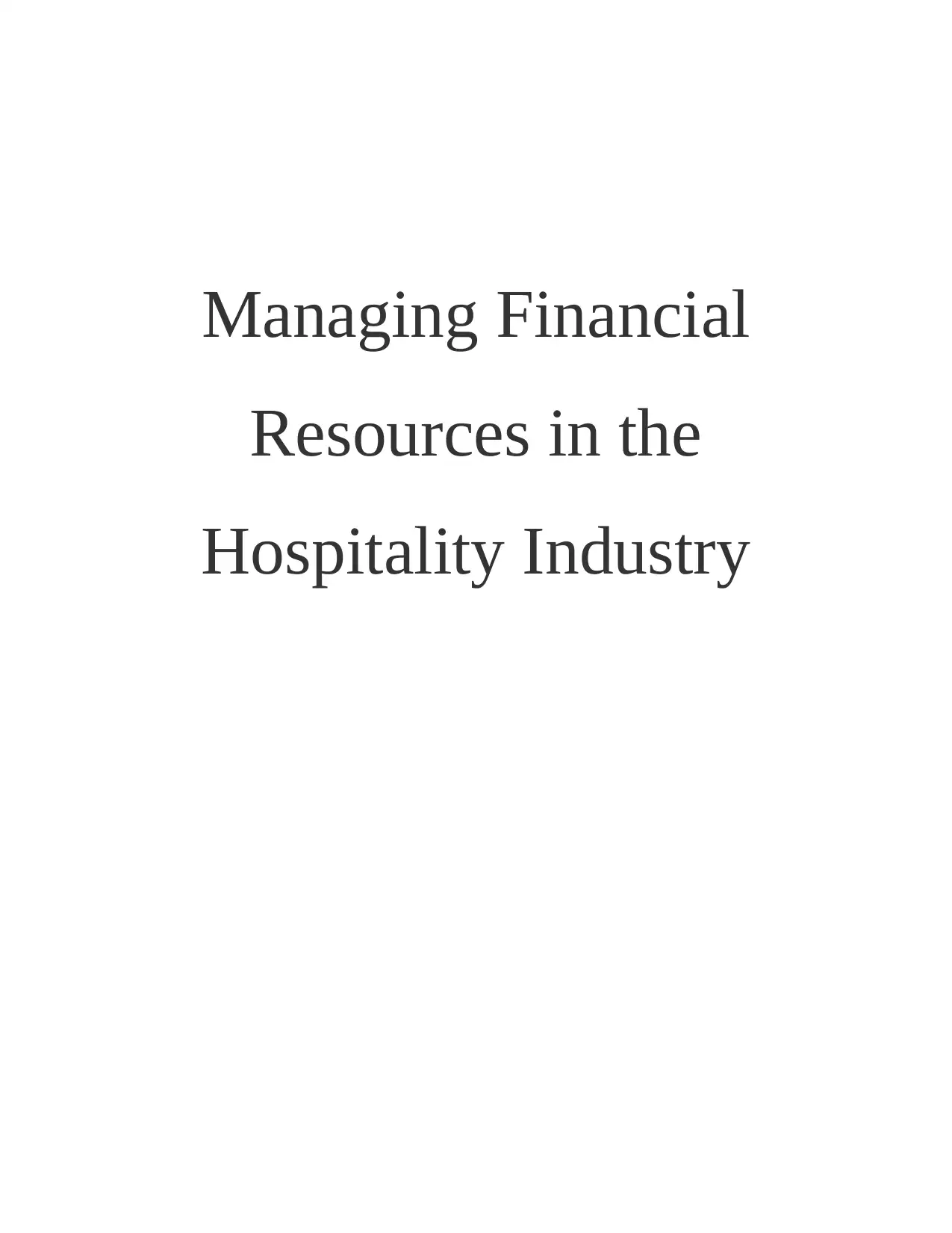
Managing Financial
Resources in the
Hospitality Industry
Resources in the
Hospitality Industry
Paraphrase This Document
Need a fresh take? Get an instant paraphrase of this document with our AI Paraphraser
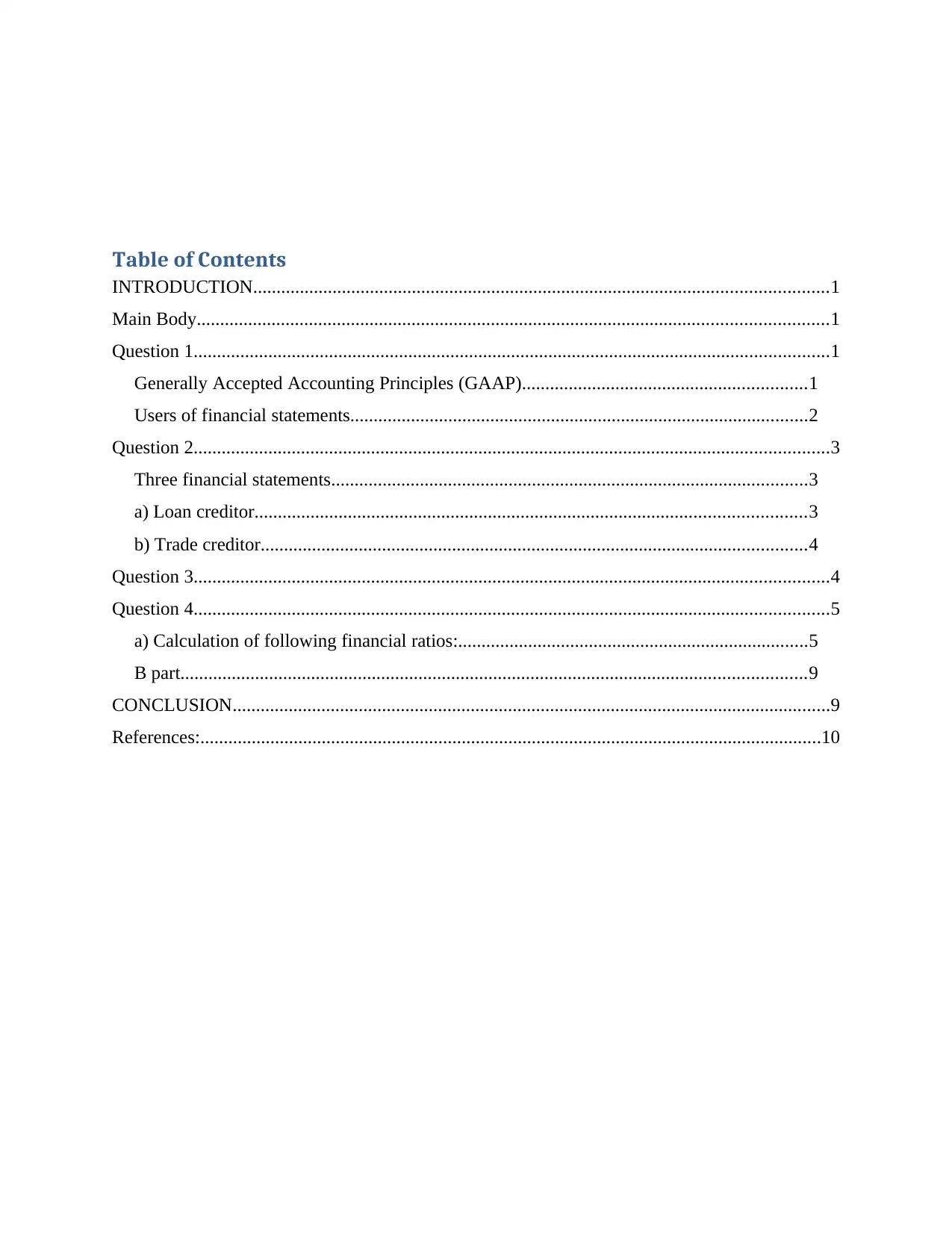
Table of Contents
INTRODUCTION...........................................................................................................................1
Main Body.......................................................................................................................................1
Question 1........................................................................................................................................1
Generally Accepted Accounting Principles (GAAP).............................................................1
Users of financial statements..................................................................................................2
Question 2........................................................................................................................................3
Three financial statements......................................................................................................3
a) Loan creditor......................................................................................................................3
b) Trade creditor.....................................................................................................................4
Question 3........................................................................................................................................4
Question 4........................................................................................................................................5
a) Calculation of following financial ratios:...........................................................................5
B part......................................................................................................................................9
CONCLUSION................................................................................................................................9
References:.....................................................................................................................................10
INTRODUCTION...........................................................................................................................1
Main Body.......................................................................................................................................1
Question 1........................................................................................................................................1
Generally Accepted Accounting Principles (GAAP).............................................................1
Users of financial statements..................................................................................................2
Question 2........................................................................................................................................3
Three financial statements......................................................................................................3
a) Loan creditor......................................................................................................................3
b) Trade creditor.....................................................................................................................4
Question 3........................................................................................................................................4
Question 4........................................................................................................................................5
a) Calculation of following financial ratios:...........................................................................5
B part......................................................................................................................................9
CONCLUSION................................................................................................................................9
References:.....................................................................................................................................10
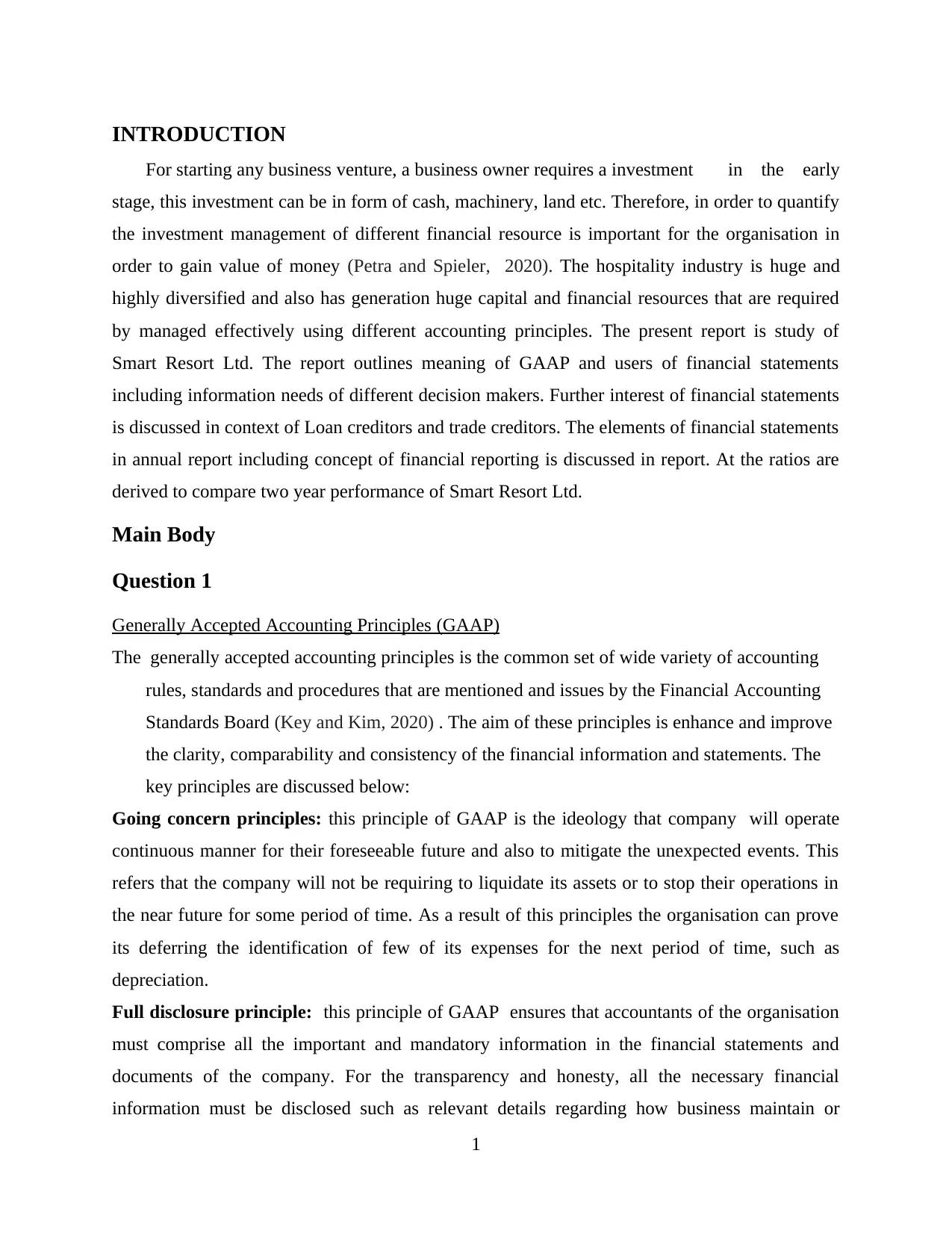
INTRODUCTION
For starting any business venture, a business owner requires a investment in the early
stage, this investment can be in form of cash, machinery, land etc. Therefore, in order to quantify
the investment management of different financial resource is important for the organisation in
order to gain value of money (Petra and Spieler, 2020). The hospitality industry is huge and
highly diversified and also has generation huge capital and financial resources that are required
by managed effectively using different accounting principles. The present report is study of
Smart Resort Ltd. The report outlines meaning of GAAP and users of financial statements
including information needs of different decision makers. Further interest of financial statements
is discussed in context of Loan creditors and trade creditors. The elements of financial statements
in annual report including concept of financial reporting is discussed in report. At the ratios are
derived to compare two year performance of Smart Resort Ltd.
Main Body
Question 1
Generally Accepted Accounting Principles (GAAP)
The generally accepted accounting principles is the common set of wide variety of accounting
rules, standards and procedures that are mentioned and issues by the Financial Accounting
Standards Board (Key and Kim, 2020) . The aim of these principles is enhance and improve
the clarity, comparability and consistency of the financial information and statements. The
key principles are discussed below:
Going concern principles: this principle of GAAP is the ideology that company will operate
continuous manner for their foreseeable future and also to mitigate the unexpected events. This
refers that the company will not be requiring to liquidate its assets or to stop their operations in
the near future for some period of time. As a result of this principles the organisation can prove
its deferring the identification of few of its expenses for the next period of time, such as
depreciation.
Full disclosure principle: this principle of GAAP ensures that accountants of the organisation
must comprise all the important and mandatory information in the financial statements and
documents of the company. For the transparency and honesty, all the necessary financial
information must be disclosed such as relevant details regarding how business maintain or
1
For starting any business venture, a business owner requires a investment in the early
stage, this investment can be in form of cash, machinery, land etc. Therefore, in order to quantify
the investment management of different financial resource is important for the organisation in
order to gain value of money (Petra and Spieler, 2020). The hospitality industry is huge and
highly diversified and also has generation huge capital and financial resources that are required
by managed effectively using different accounting principles. The present report is study of
Smart Resort Ltd. The report outlines meaning of GAAP and users of financial statements
including information needs of different decision makers. Further interest of financial statements
is discussed in context of Loan creditors and trade creditors. The elements of financial statements
in annual report including concept of financial reporting is discussed in report. At the ratios are
derived to compare two year performance of Smart Resort Ltd.
Main Body
Question 1
Generally Accepted Accounting Principles (GAAP)
The generally accepted accounting principles is the common set of wide variety of accounting
rules, standards and procedures that are mentioned and issues by the Financial Accounting
Standards Board (Key and Kim, 2020) . The aim of these principles is enhance and improve
the clarity, comparability and consistency of the financial information and statements. The
key principles are discussed below:
Going concern principles: this principle of GAAP is the ideology that company will operate
continuous manner for their foreseeable future and also to mitigate the unexpected events. This
refers that the company will not be requiring to liquidate its assets or to stop their operations in
the near future for some period of time. As a result of this principles the organisation can prove
its deferring the identification of few of its expenses for the next period of time, such as
depreciation.
Full disclosure principle: this principle of GAAP ensures that accountants of the organisation
must comprise all the important and mandatory information in the financial statements and
documents of the company. For the transparency and honesty, all the necessary financial
information must be disclosed such as relevant details regarding how business maintain or
1
⊘ This is a preview!⊘
Do you want full access?
Subscribe today to unlock all pages.

Trusted by 1+ million students worldwide
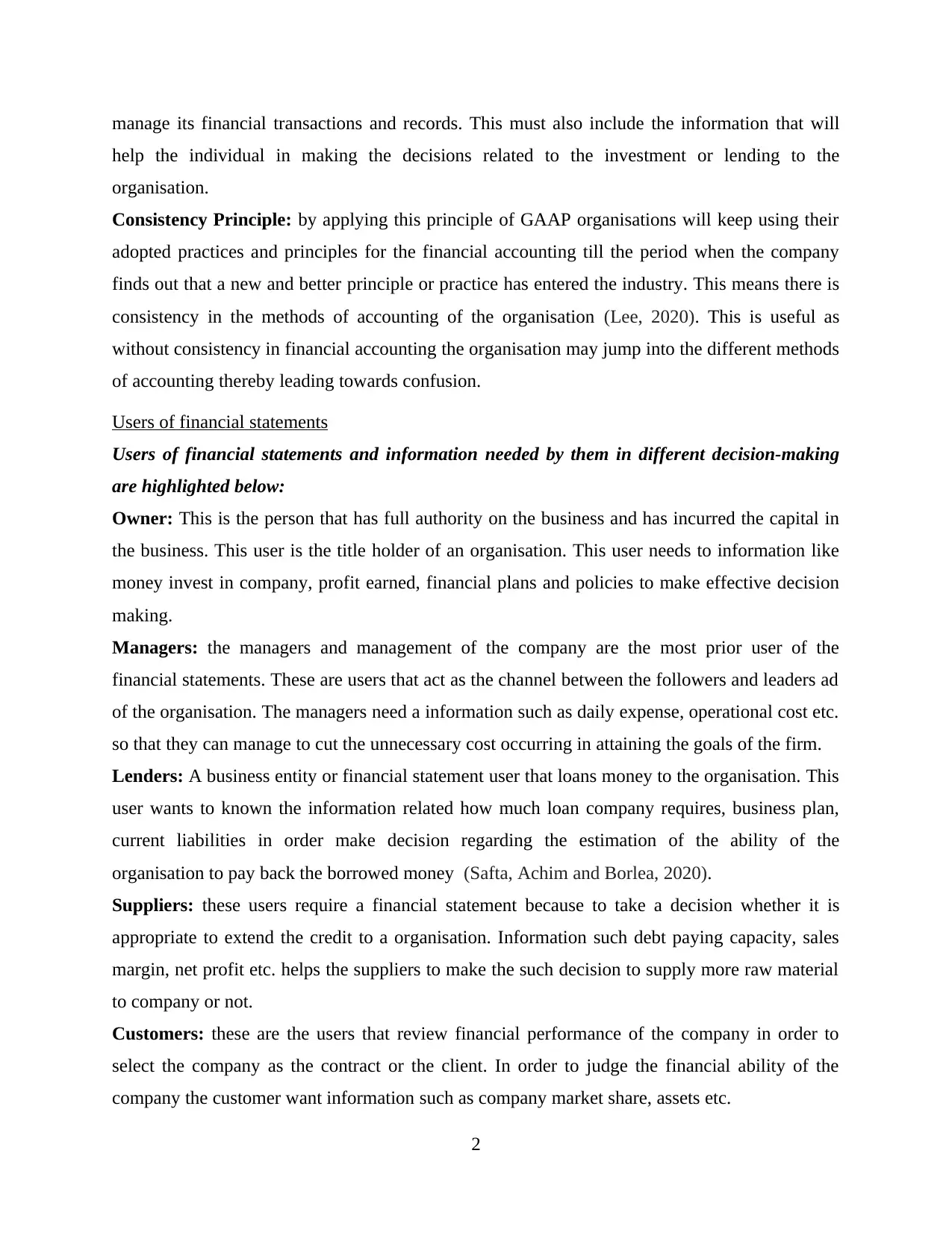
manage its financial transactions and records. This must also include the information that will
help the individual in making the decisions related to the investment or lending to the
organisation.
Consistency Principle: by applying this principle of GAAP organisations will keep using their
adopted practices and principles for the financial accounting till the period when the company
finds out that a new and better principle or practice has entered the industry. This means there is
consistency in the methods of accounting of the organisation (Lee, 2020). This is useful as
without consistency in financial accounting the organisation may jump into the different methods
of accounting thereby leading towards confusion.
Users of financial statements
Users of financial statements and information needed by them in different decision-making
are highlighted below:
Owner: This is the person that has full authority on the business and has incurred the capital in
the business. This user is the title holder of an organisation. This user needs to information like
money invest in company, profit earned, financial plans and policies to make effective decision
making.
Managers: the managers and management of the company are the most prior user of the
financial statements. These are users that act as the channel between the followers and leaders ad
of the organisation. The managers need a information such as daily expense, operational cost etc.
so that they can manage to cut the unnecessary cost occurring in attaining the goals of the firm.
Lenders: A business entity or financial statement user that loans money to the organisation. This
user wants to known the information related how much loan company requires, business plan,
current liabilities in order make decision regarding the estimation of the ability of the
organisation to pay back the borrowed money (Safta, Achim and Borlea, 2020).
Suppliers: these users require a financial statement because to take a decision whether it is
appropriate to extend the credit to a organisation. Information such debt paying capacity, sales
margin, net profit etc. helps the suppliers to make the such decision to supply more raw material
to company or not.
Customers: these are the users that review financial performance of the company in order to
select the company as the contract or the client. In order to judge the financial ability of the
company the customer want information such as company market share, assets etc.
2
help the individual in making the decisions related to the investment or lending to the
organisation.
Consistency Principle: by applying this principle of GAAP organisations will keep using their
adopted practices and principles for the financial accounting till the period when the company
finds out that a new and better principle or practice has entered the industry. This means there is
consistency in the methods of accounting of the organisation (Lee, 2020). This is useful as
without consistency in financial accounting the organisation may jump into the different methods
of accounting thereby leading towards confusion.
Users of financial statements
Users of financial statements and information needed by them in different decision-making
are highlighted below:
Owner: This is the person that has full authority on the business and has incurred the capital in
the business. This user is the title holder of an organisation. This user needs to information like
money invest in company, profit earned, financial plans and policies to make effective decision
making.
Managers: the managers and management of the company are the most prior user of the
financial statements. These are users that act as the channel between the followers and leaders ad
of the organisation. The managers need a information such as daily expense, operational cost etc.
so that they can manage to cut the unnecessary cost occurring in attaining the goals of the firm.
Lenders: A business entity or financial statement user that loans money to the organisation. This
user wants to known the information related how much loan company requires, business plan,
current liabilities in order make decision regarding the estimation of the ability of the
organisation to pay back the borrowed money (Safta, Achim and Borlea, 2020).
Suppliers: these users require a financial statement because to take a decision whether it is
appropriate to extend the credit to a organisation. Information such debt paying capacity, sales
margin, net profit etc. helps the suppliers to make the such decision to supply more raw material
to company or not.
Customers: these are the users that review financial performance of the company in order to
select the company as the contract or the client. In order to judge the financial ability of the
company the customer want information such as company market share, assets etc.
2
Paraphrase This Document
Need a fresh take? Get an instant paraphrase of this document with our AI Paraphraser
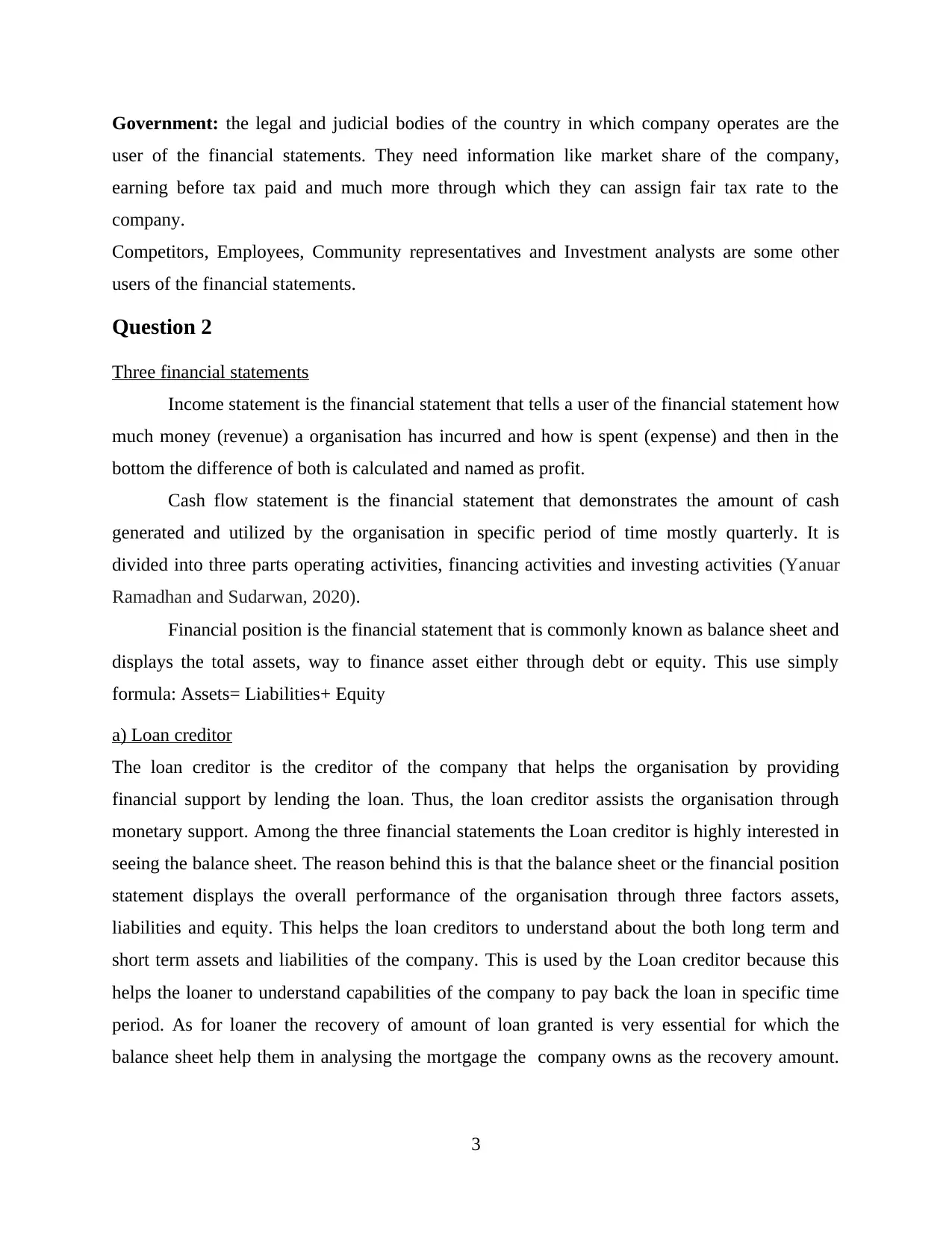
Government: the legal and judicial bodies of the country in which company operates are the
user of the financial statements. They need information like market share of the company,
earning before tax paid and much more through which they can assign fair tax rate to the
company.
Competitors, Employees, Community representatives and Investment analysts are some other
users of the financial statements.
Question 2
Three financial statements
Income statement is the financial statement that tells a user of the financial statement how
much money (revenue) a organisation has incurred and how is spent (expense) and then in the
bottom the difference of both is calculated and named as profit.
Cash flow statement is the financial statement that demonstrates the amount of cash
generated and utilized by the organisation in specific period of time mostly quarterly. It is
divided into three parts operating activities, financing activities and investing activities (Yanuar
Ramadhan and Sudarwan, 2020).
Financial position is the financial statement that is commonly known as balance sheet and
displays the total assets, way to finance asset either through debt or equity. This use simply
formula: Assets= Liabilities+ Equity
a) Loan creditor
The loan creditor is the creditor of the company that helps the organisation by providing
financial support by lending the loan. Thus, the loan creditor assists the organisation through
monetary support. Among the three financial statements the Loan creditor is highly interested in
seeing the balance sheet. The reason behind this is that the balance sheet or the financial position
statement displays the overall performance of the organisation through three factors assets,
liabilities and equity. This helps the loan creditors to understand about the both long term and
short term assets and liabilities of the company. This is used by the Loan creditor because this
helps the loaner to understand capabilities of the company to pay back the loan in specific time
period. As for loaner the recovery of amount of loan granted is very essential for which the
balance sheet help them in analysing the mortgage the company owns as the recovery amount.
3
user of the financial statements. They need information like market share of the company,
earning before tax paid and much more through which they can assign fair tax rate to the
company.
Competitors, Employees, Community representatives and Investment analysts are some other
users of the financial statements.
Question 2
Three financial statements
Income statement is the financial statement that tells a user of the financial statement how
much money (revenue) a organisation has incurred and how is spent (expense) and then in the
bottom the difference of both is calculated and named as profit.
Cash flow statement is the financial statement that demonstrates the amount of cash
generated and utilized by the organisation in specific period of time mostly quarterly. It is
divided into three parts operating activities, financing activities and investing activities (Yanuar
Ramadhan and Sudarwan, 2020).
Financial position is the financial statement that is commonly known as balance sheet and
displays the total assets, way to finance asset either through debt or equity. This use simply
formula: Assets= Liabilities+ Equity
a) Loan creditor
The loan creditor is the creditor of the company that helps the organisation by providing
financial support by lending the loan. Thus, the loan creditor assists the organisation through
monetary support. Among the three financial statements the Loan creditor is highly interested in
seeing the balance sheet. The reason behind this is that the balance sheet or the financial position
statement displays the overall performance of the organisation through three factors assets,
liabilities and equity. This helps the loan creditors to understand about the both long term and
short term assets and liabilities of the company. This is used by the Loan creditor because this
helps the loaner to understand capabilities of the company to pay back the loan in specific time
period. As for loaner the recovery of amount of loan granted is very essential for which the
balance sheet help them in analysing the mortgage the company owns as the recovery amount.
3
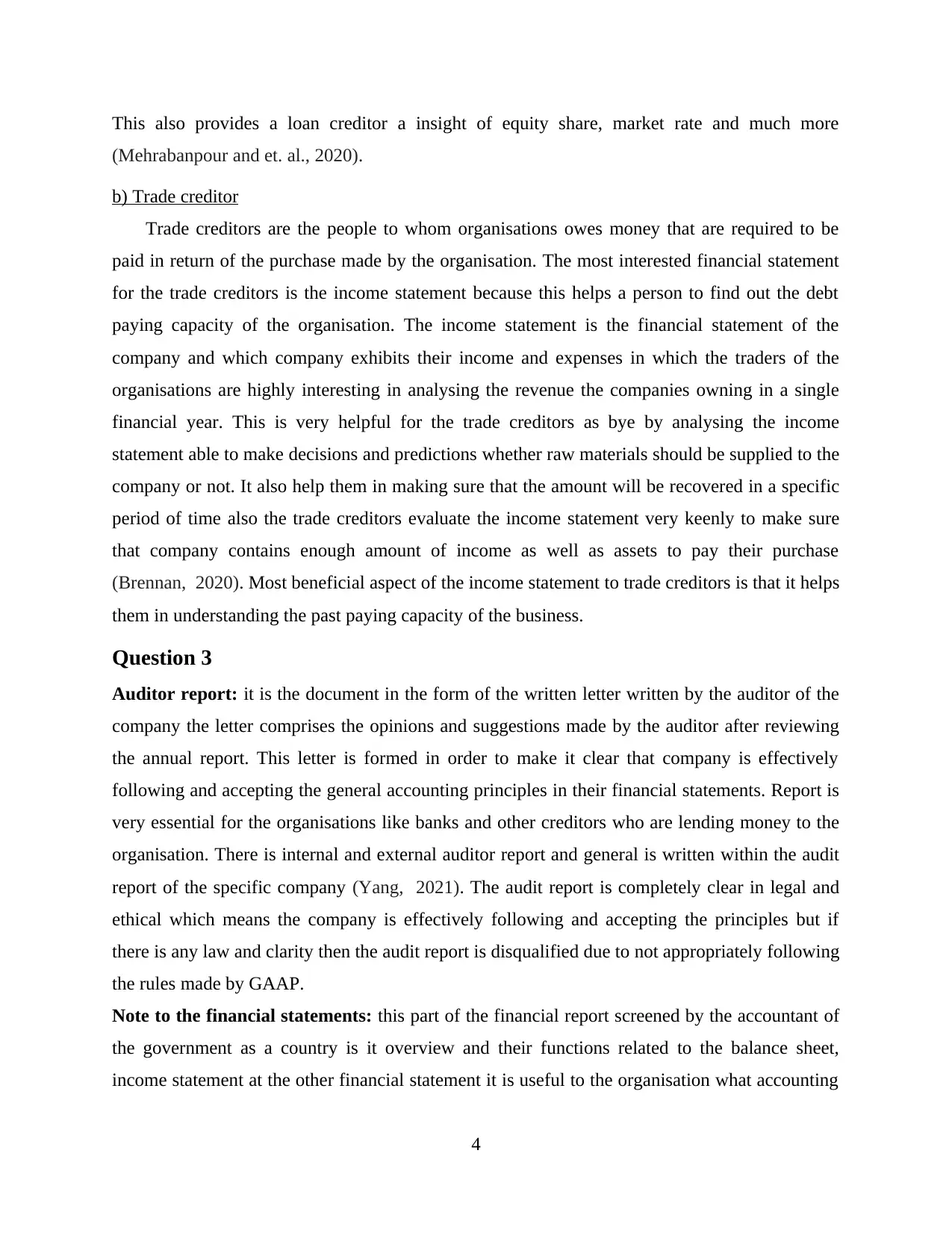
This also provides a loan creditor a insight of equity share, market rate and much more
(Mehrabanpour and et. al., 2020).
b) Trade creditor
Trade creditors are the people to whom organisations owes money that are required to be
paid in return of the purchase made by the organisation. The most interested financial statement
for the trade creditors is the income statement because this helps a person to find out the debt
paying capacity of the organisation. The income statement is the financial statement of the
company and which company exhibits their income and expenses in which the traders of the
organisations are highly interesting in analysing the revenue the companies owning in a single
financial year. This is very helpful for the trade creditors as bye by analysing the income
statement able to make decisions and predictions whether raw materials should be supplied to the
company or not. It also help them in making sure that the amount will be recovered in a specific
period of time also the trade creditors evaluate the income statement very keenly to make sure
that company contains enough amount of income as well as assets to pay their purchase
(Brennan, 2020). Most beneficial aspect of the income statement to trade creditors is that it helps
them in understanding the past paying capacity of the business.
Question 3
Auditor report: it is the document in the form of the written letter written by the auditor of the
company the letter comprises the opinions and suggestions made by the auditor after reviewing
the annual report. This letter is formed in order to make it clear that company is effectively
following and accepting the general accounting principles in their financial statements. Report is
very essential for the organisations like banks and other creditors who are lending money to the
organisation. There is internal and external auditor report and general is written within the audit
report of the specific company (Yang, 2021). The audit report is completely clear in legal and
ethical which means the company is effectively following and accepting the principles but if
there is any law and clarity then the audit report is disqualified due to not appropriately following
the rules made by GAAP.
Note to the financial statements: this part of the financial report screened by the accountant of
the government as a country is it overview and their functions related to the balance sheet,
income statement at the other financial statement it is useful to the organisation what accounting
4
(Mehrabanpour and et. al., 2020).
b) Trade creditor
Trade creditors are the people to whom organisations owes money that are required to be
paid in return of the purchase made by the organisation. The most interested financial statement
for the trade creditors is the income statement because this helps a person to find out the debt
paying capacity of the organisation. The income statement is the financial statement of the
company and which company exhibits their income and expenses in which the traders of the
organisations are highly interesting in analysing the revenue the companies owning in a single
financial year. This is very helpful for the trade creditors as bye by analysing the income
statement able to make decisions and predictions whether raw materials should be supplied to the
company or not. It also help them in making sure that the amount will be recovered in a specific
period of time also the trade creditors evaluate the income statement very keenly to make sure
that company contains enough amount of income as well as assets to pay their purchase
(Brennan, 2020). Most beneficial aspect of the income statement to trade creditors is that it helps
them in understanding the past paying capacity of the business.
Question 3
Auditor report: it is the document in the form of the written letter written by the auditor of the
company the letter comprises the opinions and suggestions made by the auditor after reviewing
the annual report. This letter is formed in order to make it clear that company is effectively
following and accepting the general accounting principles in their financial statements. Report is
very essential for the organisations like banks and other creditors who are lending money to the
organisation. There is internal and external auditor report and general is written within the audit
report of the specific company (Yang, 2021). The audit report is completely clear in legal and
ethical which means the company is effectively following and accepting the principles but if
there is any law and clarity then the audit report is disqualified due to not appropriately following
the rules made by GAAP.
Note to the financial statements: this part of the financial report screened by the accountant of
the government as a country is it overview and their functions related to the balance sheet,
income statement at the other financial statement it is useful to the organisation what accounting
4
⊘ This is a preview!⊘
Do you want full access?
Subscribe today to unlock all pages.

Trusted by 1+ million students worldwide
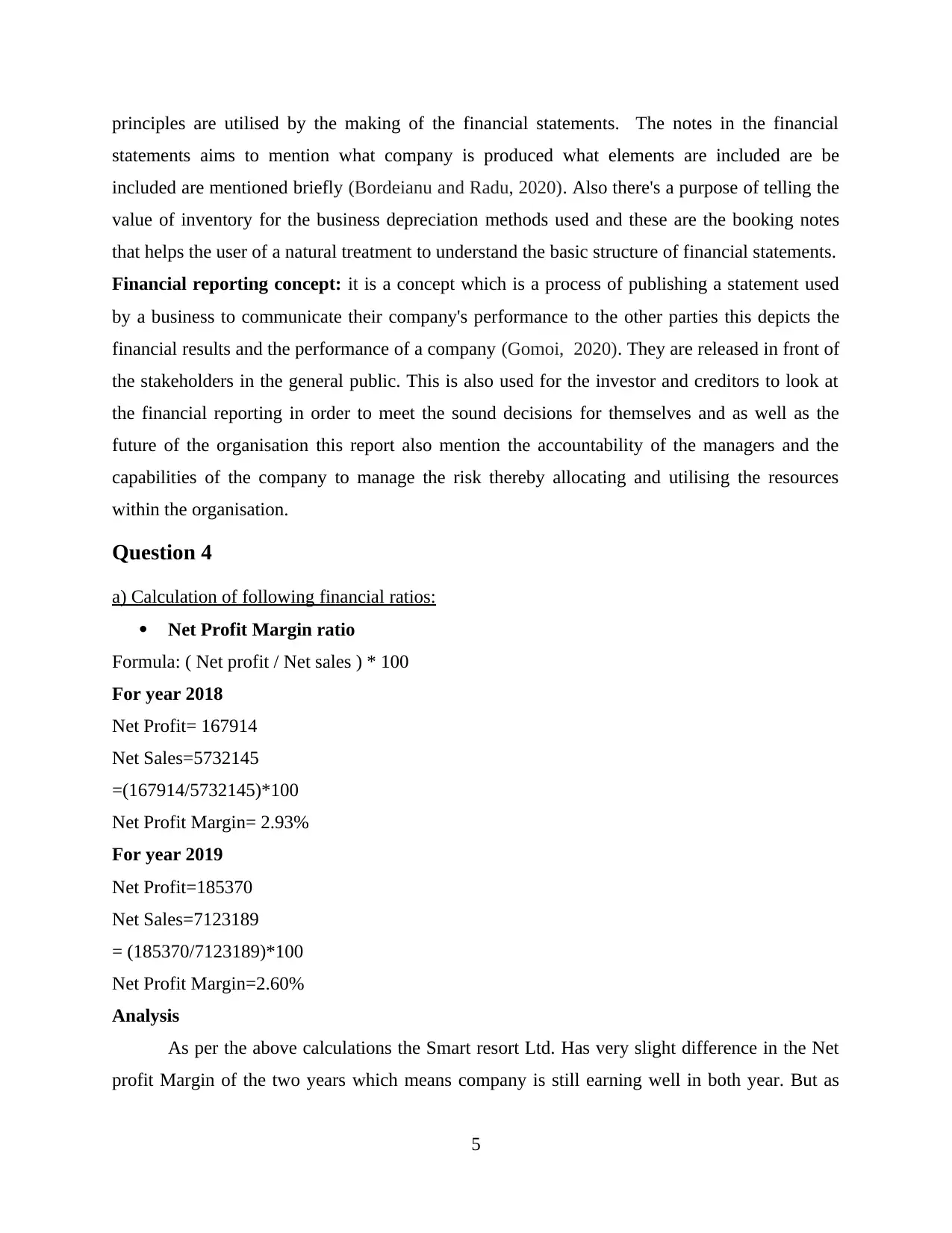
principles are utilised by the making of the financial statements. The notes in the financial
statements aims to mention what company is produced what elements are included are be
included are mentioned briefly (Bordeianu and Radu, 2020). Also there's a purpose of telling the
value of inventory for the business depreciation methods used and these are the booking notes
that helps the user of a natural treatment to understand the basic structure of financial statements.
Financial reporting concept: it is a concept which is a process of publishing a statement used
by a business to communicate their company's performance to the other parties this depicts the
financial results and the performance of a company (Gomoi, 2020). They are released in front of
the stakeholders in the general public. This is also used for the investor and creditors to look at
the financial reporting in order to meet the sound decisions for themselves and as well as the
future of the organisation this report also mention the accountability of the managers and the
capabilities of the company to manage the risk thereby allocating and utilising the resources
within the organisation.
Question 4
a) Calculation of following financial ratios:
Net Profit Margin ratio
Formula: ( Net profit / Net sales ) * 100
For year 2018
Net Profit= 167914
Net Sales=5732145
=(167914/5732145)*100
Net Profit Margin= 2.93%
For year 2019
Net Profit=185370
Net Sales=7123189
= (185370/7123189)*100
Net Profit Margin=2.60%
Analysis
As per the above calculations the Smart resort Ltd. Has very slight difference in the Net
profit Margin of the two years which means company is still earning well in both year. But as
5
statements aims to mention what company is produced what elements are included are be
included are mentioned briefly (Bordeianu and Radu, 2020). Also there's a purpose of telling the
value of inventory for the business depreciation methods used and these are the booking notes
that helps the user of a natural treatment to understand the basic structure of financial statements.
Financial reporting concept: it is a concept which is a process of publishing a statement used
by a business to communicate their company's performance to the other parties this depicts the
financial results and the performance of a company (Gomoi, 2020). They are released in front of
the stakeholders in the general public. This is also used for the investor and creditors to look at
the financial reporting in order to meet the sound decisions for themselves and as well as the
future of the organisation this report also mention the accountability of the managers and the
capabilities of the company to manage the risk thereby allocating and utilising the resources
within the organisation.
Question 4
a) Calculation of following financial ratios:
Net Profit Margin ratio
Formula: ( Net profit / Net sales ) * 100
For year 2018
Net Profit= 167914
Net Sales=5732145
=(167914/5732145)*100
Net Profit Margin= 2.93%
For year 2019
Net Profit=185370
Net Sales=7123189
= (185370/7123189)*100
Net Profit Margin=2.60%
Analysis
As per the above calculations the Smart resort Ltd. Has very slight difference in the Net
profit Margin of the two years which means company is still earning well in both year. But as
5
Paraphrase This Document
Need a fresh take? Get an instant paraphrase of this document with our AI Paraphraser
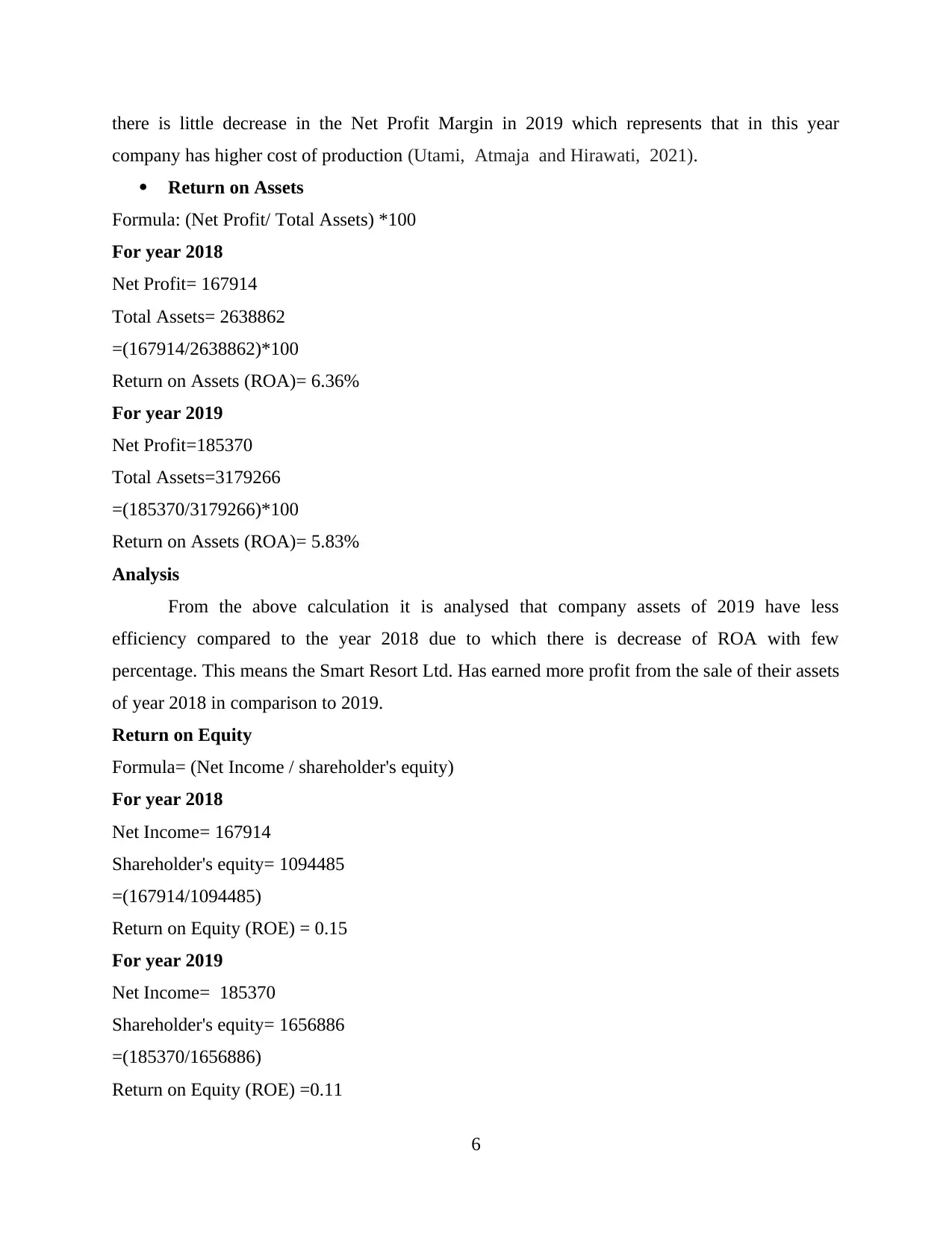
there is little decrease in the Net Profit Margin in 2019 which represents that in this year
company has higher cost of production (Utami, Atmaja and Hirawati, 2021).
Return on Assets
Formula: (Net Profit/ Total Assets) *100
For year 2018
Net Profit= 167914
Total Assets= 2638862
=(167914/2638862)*100
Return on Assets (ROA)= 6.36%
For year 2019
Net Profit=185370
Total Assets=3179266
=(185370/3179266)*100
Return on Assets (ROA)= 5.83%
Analysis
From the above calculation it is analysed that company assets of 2019 have less
efficiency compared to the year 2018 due to which there is decrease of ROA with few
percentage. This means the Smart Resort Ltd. Has earned more profit from the sale of their assets
of year 2018 in comparison to 2019.
Return on Equity
Formula= (Net Income / shareholder's equity)
For year 2018
Net Income= 167914
Shareholder's equity= 1094485
=(167914/1094485)
Return on Equity (ROE) = 0.15
For year 2019
Net Income= 185370
Shareholder's equity= 1656886
=(185370/1656886)
Return on Equity (ROE) =0.11
6
company has higher cost of production (Utami, Atmaja and Hirawati, 2021).
Return on Assets
Formula: (Net Profit/ Total Assets) *100
For year 2018
Net Profit= 167914
Total Assets= 2638862
=(167914/2638862)*100
Return on Assets (ROA)= 6.36%
For year 2019
Net Profit=185370
Total Assets=3179266
=(185370/3179266)*100
Return on Assets (ROA)= 5.83%
Analysis
From the above calculation it is analysed that company assets of 2019 have less
efficiency compared to the year 2018 due to which there is decrease of ROA with few
percentage. This means the Smart Resort Ltd. Has earned more profit from the sale of their assets
of year 2018 in comparison to 2019.
Return on Equity
Formula= (Net Income / shareholder's equity)
For year 2018
Net Income= 167914
Shareholder's equity= 1094485
=(167914/1094485)
Return on Equity (ROE) = 0.15
For year 2019
Net Income= 185370
Shareholder's equity= 1656886
=(185370/1656886)
Return on Equity (ROE) =0.11
6
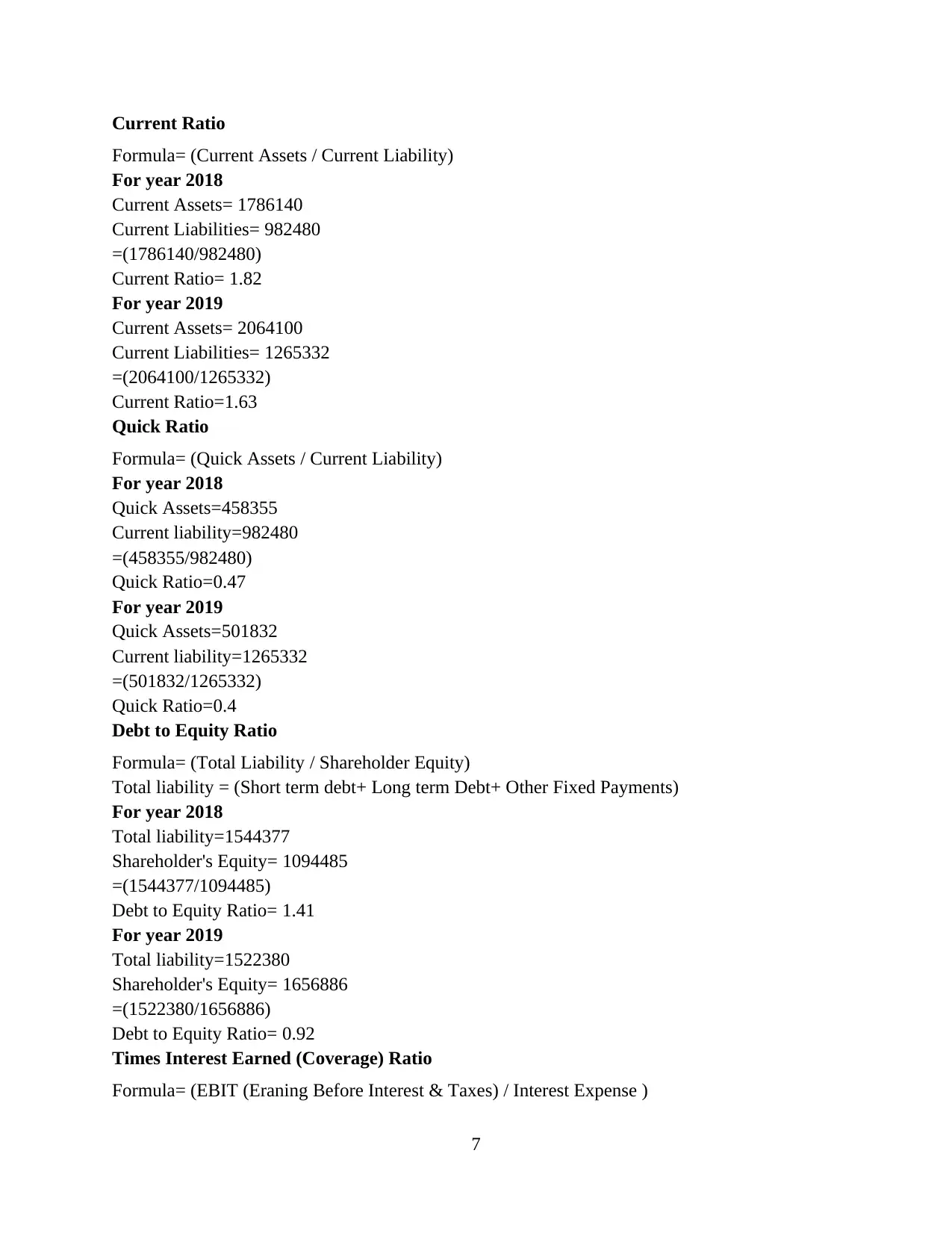
Current Ratio
Formula= (Current Assets / Current Liability)
For year 2018
Current Assets= 1786140
Current Liabilities= 982480
=(1786140/982480)
Current Ratio= 1.82
For year 2019
Current Assets= 2064100
Current Liabilities= 1265332
=(2064100/1265332)
Current Ratio=1.63
Quick Ratio
Formula= (Quick Assets / Current Liability)
For year 2018
Quick Assets=458355
Current liability=982480
=(458355/982480)
Quick Ratio=0.47
For year 2019
Quick Assets=501832
Current liability=1265332
=(501832/1265332)
Quick Ratio=0.4
Debt to Equity Ratio
Formula= (Total Liability / Shareholder Equity)
Total liability = (Short term debt+ Long term Debt+ Other Fixed Payments)
For year 2018
Total liability=1544377
Shareholder's Equity= 1094485
=(1544377/1094485)
Debt to Equity Ratio= 1.41
For year 2019
Total liability=1522380
Shareholder's Equity= 1656886
=(1522380/1656886)
Debt to Equity Ratio= 0.92
Times Interest Earned (Coverage) Ratio
Formula= (EBIT (Eraning Before Interest & Taxes) / Interest Expense )
7
Formula= (Current Assets / Current Liability)
For year 2018
Current Assets= 1786140
Current Liabilities= 982480
=(1786140/982480)
Current Ratio= 1.82
For year 2019
Current Assets= 2064100
Current Liabilities= 1265332
=(2064100/1265332)
Current Ratio=1.63
Quick Ratio
Formula= (Quick Assets / Current Liability)
For year 2018
Quick Assets=458355
Current liability=982480
=(458355/982480)
Quick Ratio=0.47
For year 2019
Quick Assets=501832
Current liability=1265332
=(501832/1265332)
Quick Ratio=0.4
Debt to Equity Ratio
Formula= (Total Liability / Shareholder Equity)
Total liability = (Short term debt+ Long term Debt+ Other Fixed Payments)
For year 2018
Total liability=1544377
Shareholder's Equity= 1094485
=(1544377/1094485)
Debt to Equity Ratio= 1.41
For year 2019
Total liability=1522380
Shareholder's Equity= 1656886
=(1522380/1656886)
Debt to Equity Ratio= 0.92
Times Interest Earned (Coverage) Ratio
Formula= (EBIT (Eraning Before Interest & Taxes) / Interest Expense )
7
⊘ This is a preview!⊘
Do you want full access?
Subscribe today to unlock all pages.

Trusted by 1+ million students worldwide
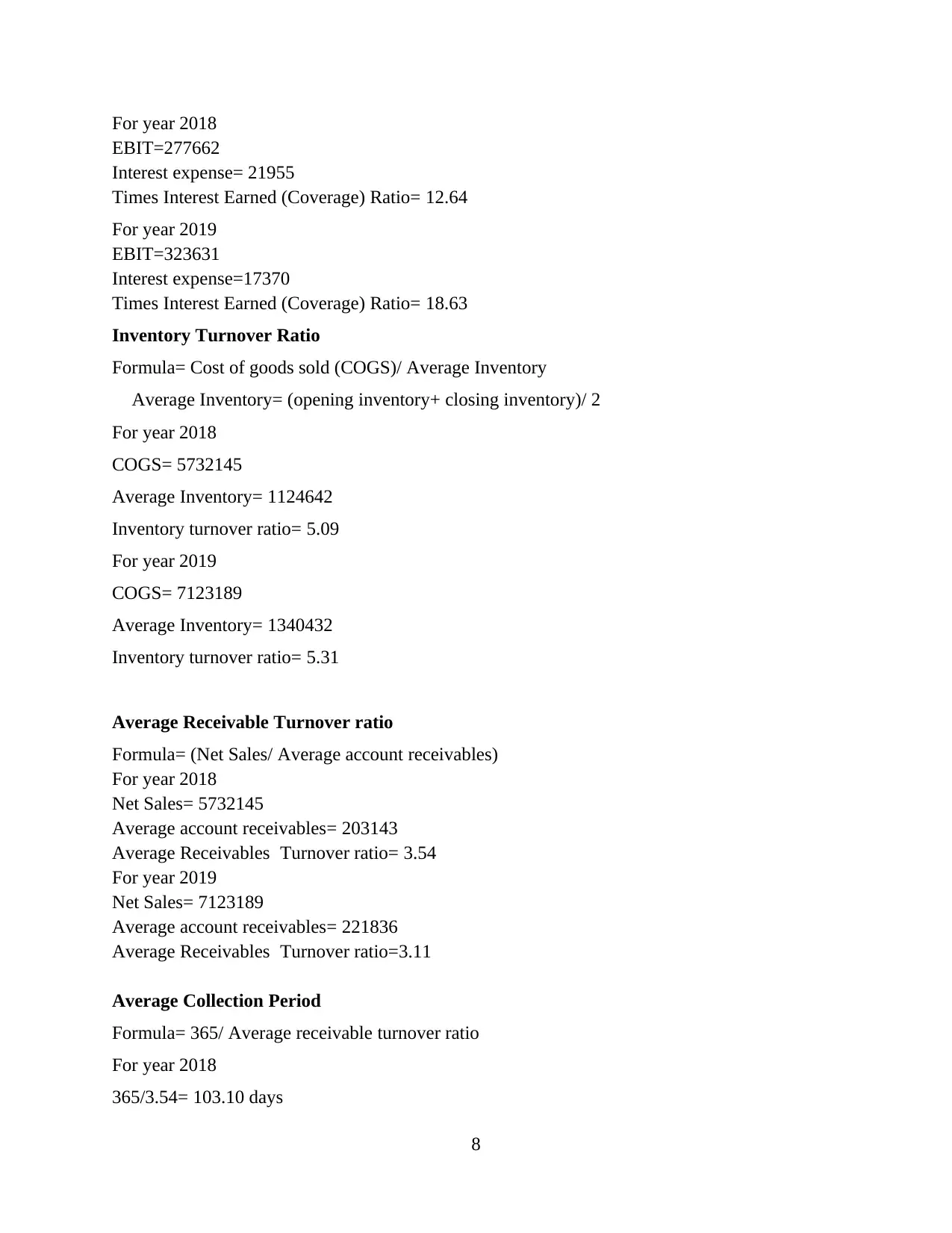
For year 2018
EBIT=277662
Interest expense= 21955
Times Interest Earned (Coverage) Ratio= 12.64
For year 2019
EBIT=323631
Interest expense=17370
Times Interest Earned (Coverage) Ratio= 18.63
Inventory Turnover Ratio
Formula= Cost of goods sold (COGS)/ Average Inventory
Average Inventory= (opening inventory+ closing inventory)/ 2
For year 2018
COGS= 5732145
Average Inventory= 1124642
Inventory turnover ratio= 5.09
For year 2019
COGS= 7123189
Average Inventory= 1340432
Inventory turnover ratio= 5.31
Average Receivable Turnover ratio
Formula= (Net Sales/ Average account receivables)
For year 2018
Net Sales= 5732145
Average account receivables= 203143
Average Receivables Turnover ratio= 3.54
For year 2019
Net Sales= 7123189
Average account receivables= 221836
Average Receivables Turnover ratio=3.11
Average Collection Period
Formula= 365/ Average receivable turnover ratio
For year 2018
365/3.54= 103.10 days
8
EBIT=277662
Interest expense= 21955
Times Interest Earned (Coverage) Ratio= 12.64
For year 2019
EBIT=323631
Interest expense=17370
Times Interest Earned (Coverage) Ratio= 18.63
Inventory Turnover Ratio
Formula= Cost of goods sold (COGS)/ Average Inventory
Average Inventory= (opening inventory+ closing inventory)/ 2
For year 2018
COGS= 5732145
Average Inventory= 1124642
Inventory turnover ratio= 5.09
For year 2019
COGS= 7123189
Average Inventory= 1340432
Inventory turnover ratio= 5.31
Average Receivable Turnover ratio
Formula= (Net Sales/ Average account receivables)
For year 2018
Net Sales= 5732145
Average account receivables= 203143
Average Receivables Turnover ratio= 3.54
For year 2019
Net Sales= 7123189
Average account receivables= 221836
Average Receivables Turnover ratio=3.11
Average Collection Period
Formula= 365/ Average receivable turnover ratio
For year 2018
365/3.54= 103.10 days
8
Paraphrase This Document
Need a fresh take? Get an instant paraphrase of this document with our AI Paraphraser
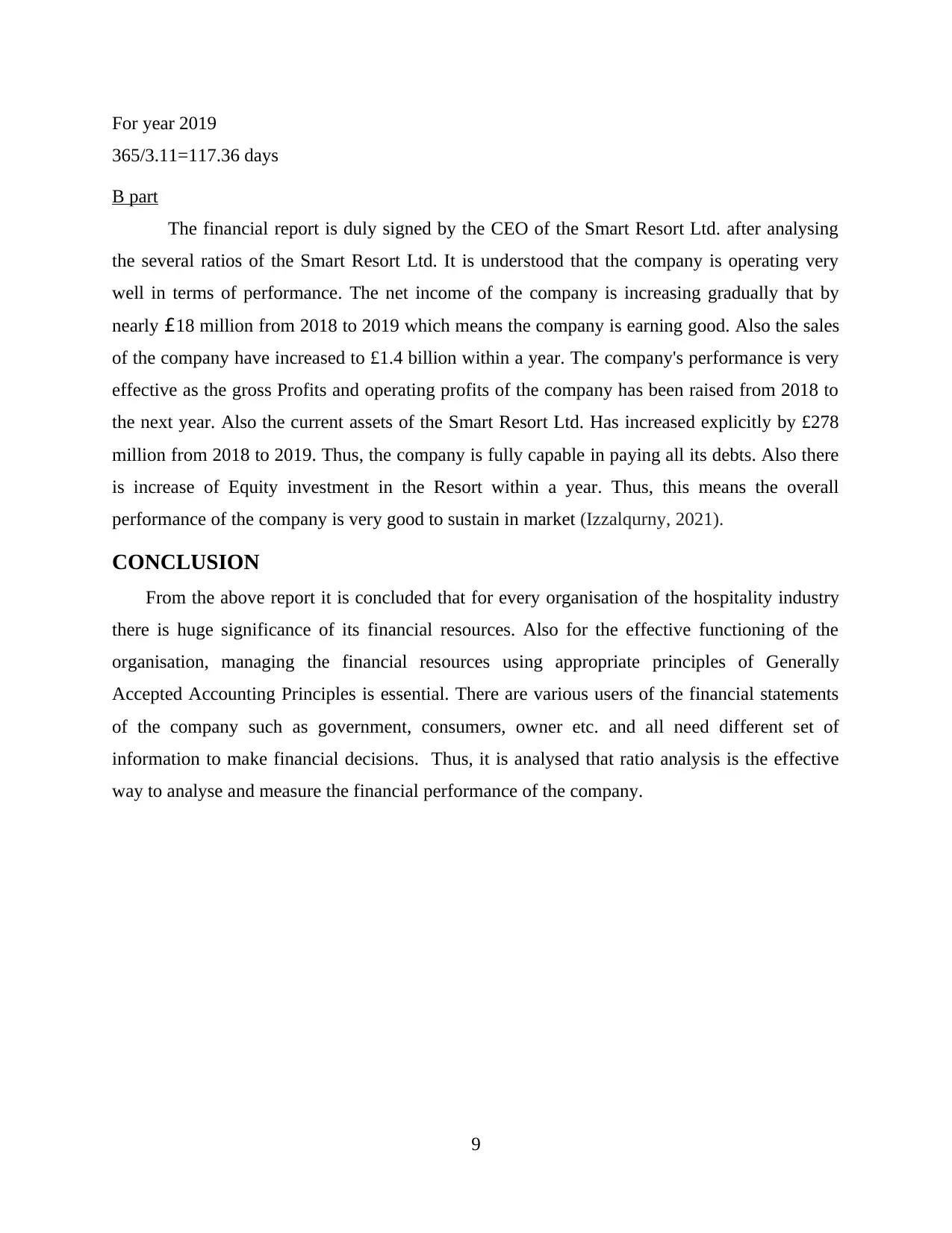
For year 2019
365/3.11=117.36 days
B part
The financial report is duly signed by the CEO of the Smart Resort Ltd. after analysing
the several ratios of the Smart Resort Ltd. It is understood that the company is operating very
well in terms of performance. The net income of the company is increasing gradually that by
nearly £18 million from 2018 to 2019 which means the company is earning good. Also the sales
of the company have increased to £1.4 billion within a year. The company's performance is very
effective as the gross Profits and operating profits of the company has been raised from 2018 to
the next year. Also the current assets of the Smart Resort Ltd. Has increased explicitly by £278
million from 2018 to 2019. Thus, the company is fully capable in paying all its debts. Also there
is increase of Equity investment in the Resort within a year. Thus, this means the overall
performance of the company is very good to sustain in market (Izzalqurny, 2021).
CONCLUSION
From the above report it is concluded that for every organisation of the hospitality industry
there is huge significance of its financial resources. Also for the effective functioning of the
organisation, managing the financial resources using appropriate principles of Generally
Accepted Accounting Principles is essential. There are various users of the financial statements
of the company such as government, consumers, owner etc. and all need different set of
information to make financial decisions. Thus, it is analysed that ratio analysis is the effective
way to analyse and measure the financial performance of the company.
9
365/3.11=117.36 days
B part
The financial report is duly signed by the CEO of the Smart Resort Ltd. after analysing
the several ratios of the Smart Resort Ltd. It is understood that the company is operating very
well in terms of performance. The net income of the company is increasing gradually that by
nearly £18 million from 2018 to 2019 which means the company is earning good. Also the sales
of the company have increased to £1.4 billion within a year. The company's performance is very
effective as the gross Profits and operating profits of the company has been raised from 2018 to
the next year. Also the current assets of the Smart Resort Ltd. Has increased explicitly by £278
million from 2018 to 2019. Thus, the company is fully capable in paying all its debts. Also there
is increase of Equity investment in the Resort within a year. Thus, this means the overall
performance of the company is very good to sustain in market (Izzalqurny, 2021).
CONCLUSION
From the above report it is concluded that for every organisation of the hospitality industry
there is huge significance of its financial resources. Also for the effective functioning of the
organisation, managing the financial resources using appropriate principles of Generally
Accepted Accounting Principles is essential. There are various users of the financial statements
of the company such as government, consumers, owner etc. and all need different set of
information to make financial decisions. Thus, it is analysed that ratio analysis is the effective
way to analyse and measure the financial performance of the company.
9
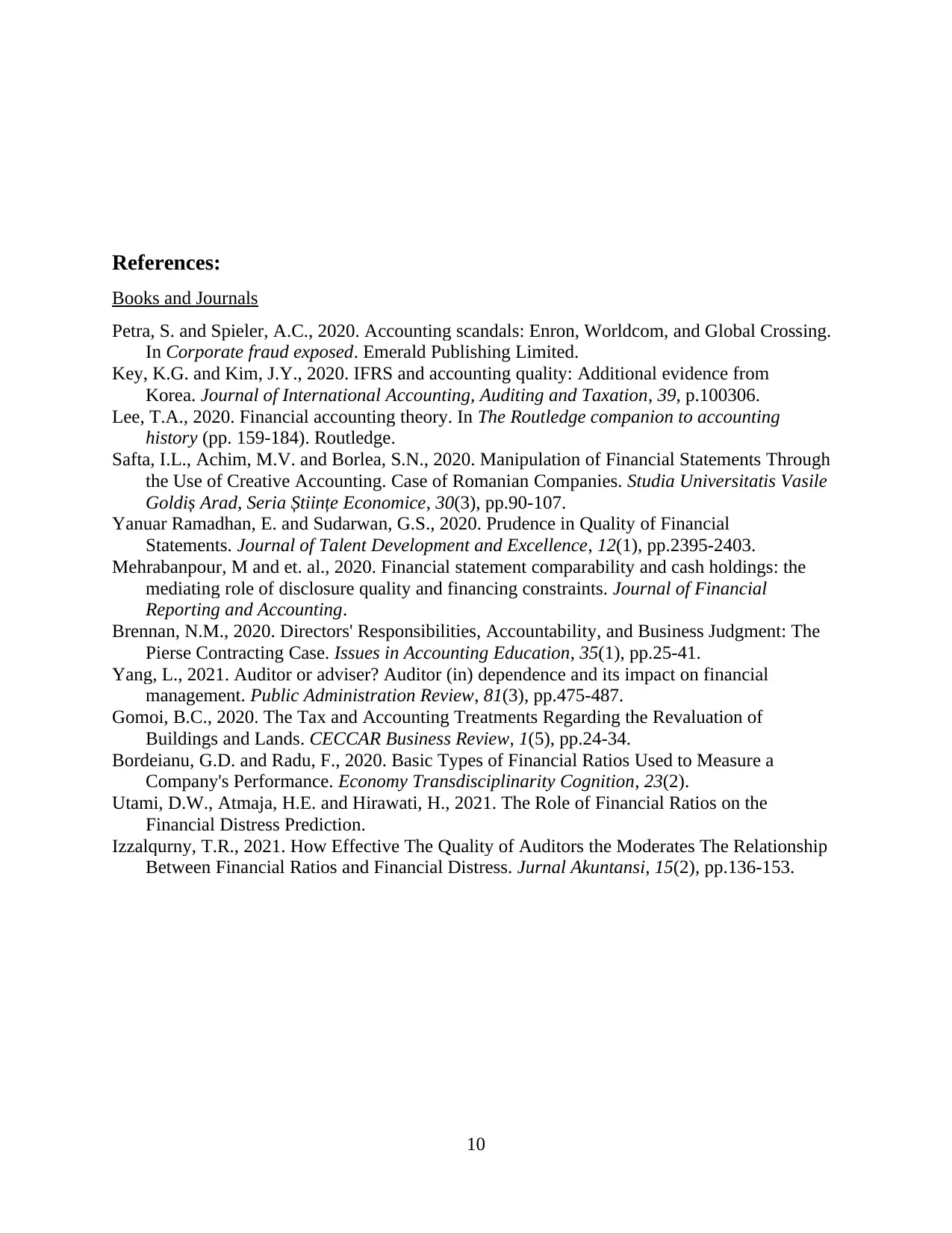
References:
Books and Journals
Petra, S. and Spieler, A.C., 2020. Accounting scandals: Enron, Worldcom, and Global Crossing.
In Corporate fraud exposed. Emerald Publishing Limited.
Key, K.G. and Kim, J.Y., 2020. IFRS and accounting quality: Additional evidence from
Korea. Journal of International Accounting, Auditing and Taxation, 39, p.100306.
Lee, T.A., 2020. Financial accounting theory. In The Routledge companion to accounting
history (pp. 159-184). Routledge.
Safta, I.L., Achim, M.V. and Borlea, S.N., 2020. Manipulation of Financial Statements Through
the Use of Creative Accounting. Case of Romanian Companies. Studia Universitatis Vasile
Goldiș Arad, Seria Științe Economice, 30(3), pp.90-107.
Yanuar Ramadhan, E. and Sudarwan, G.S., 2020. Prudence in Quality of Financial
Statements. Journal of Talent Development and Excellence, 12(1), pp.2395-2403.
Mehrabanpour, M and et. al., 2020. Financial statement comparability and cash holdings: the
mediating role of disclosure quality and financing constraints. Journal of Financial
Reporting and Accounting.
Brennan, N.M., 2020. Directors' Responsibilities, Accountability, and Business Judgment: The
Pierse Contracting Case. Issues in Accounting Education, 35(1), pp.25-41.
Yang, L., 2021. Auditor or adviser? Auditor (in) dependence and its impact on financial
management. Public Administration Review, 81(3), pp.475-487.
Gomoi, B.C., 2020. The Tax and Accounting Treatments Regarding the Revaluation of
Buildings and Lands. CECCAR Business Review, 1(5), pp.24-34.
Bordeianu, G.D. and Radu, F., 2020. Basic Types of Financial Ratios Used to Measure a
Company's Performance. Economy Transdisciplinarity Cognition, 23(2).
Utami, D.W., Atmaja, H.E. and Hirawati, H., 2021. The Role of Financial Ratios on the
Financial Distress Prediction.
Izzalqurny, T.R., 2021. How Effective The Quality of Auditors the Moderates The Relationship
Between Financial Ratios and Financial Distress. Jurnal Akuntansi, 15(2), pp.136-153.
10
Books and Journals
Petra, S. and Spieler, A.C., 2020. Accounting scandals: Enron, Worldcom, and Global Crossing.
In Corporate fraud exposed. Emerald Publishing Limited.
Key, K.G. and Kim, J.Y., 2020. IFRS and accounting quality: Additional evidence from
Korea. Journal of International Accounting, Auditing and Taxation, 39, p.100306.
Lee, T.A., 2020. Financial accounting theory. In The Routledge companion to accounting
history (pp. 159-184). Routledge.
Safta, I.L., Achim, M.V. and Borlea, S.N., 2020. Manipulation of Financial Statements Through
the Use of Creative Accounting. Case of Romanian Companies. Studia Universitatis Vasile
Goldiș Arad, Seria Științe Economice, 30(3), pp.90-107.
Yanuar Ramadhan, E. and Sudarwan, G.S., 2020. Prudence in Quality of Financial
Statements. Journal of Talent Development and Excellence, 12(1), pp.2395-2403.
Mehrabanpour, M and et. al., 2020. Financial statement comparability and cash holdings: the
mediating role of disclosure quality and financing constraints. Journal of Financial
Reporting and Accounting.
Brennan, N.M., 2020. Directors' Responsibilities, Accountability, and Business Judgment: The
Pierse Contracting Case. Issues in Accounting Education, 35(1), pp.25-41.
Yang, L., 2021. Auditor or adviser? Auditor (in) dependence and its impact on financial
management. Public Administration Review, 81(3), pp.475-487.
Gomoi, B.C., 2020. The Tax and Accounting Treatments Regarding the Revaluation of
Buildings and Lands. CECCAR Business Review, 1(5), pp.24-34.
Bordeianu, G.D. and Radu, F., 2020. Basic Types of Financial Ratios Used to Measure a
Company's Performance. Economy Transdisciplinarity Cognition, 23(2).
Utami, D.W., Atmaja, H.E. and Hirawati, H., 2021. The Role of Financial Ratios on the
Financial Distress Prediction.
Izzalqurny, T.R., 2021. How Effective The Quality of Auditors the Moderates The Relationship
Between Financial Ratios and Financial Distress. Jurnal Akuntansi, 15(2), pp.136-153.
10
⊘ This is a preview!⊘
Do you want full access?
Subscribe today to unlock all pages.

Trusted by 1+ million students worldwide
1 out of 12
Related Documents
Your All-in-One AI-Powered Toolkit for Academic Success.
+13062052269
info@desklib.com
Available 24*7 on WhatsApp / Email
![[object Object]](/_next/static/media/star-bottom.7253800d.svg)
Unlock your academic potential
Copyright © 2020–2025 A2Z Services. All Rights Reserved. Developed and managed by ZUCOL.



